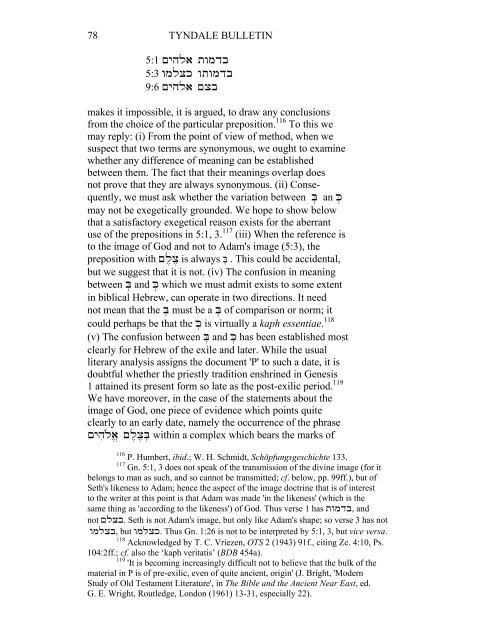THE IMAGE OF GOD IN MAN - Tyndale House
THE IMAGE OF GOD IN MAN - Tyndale House
THE IMAGE OF GOD IN MAN - Tyndale House
- TAGS
- tyndale
- tyndalehouse.com
Create successful ePaper yourself
Turn your PDF publications into a flip-book with our unique Google optimized e-Paper software.
78 TYNDALE BULLET<strong>IN</strong><br />
5:1 םיהלא תומדב<br />
5:3 ומלצכ ותומדב<br />
9:6 םיהלא םצב<br />
makes it impossible, it is argued, to draw any conclusions<br />
from the choice of the particular preposition. 116 To this we<br />
may reply: (i) From the point of view of method, when we<br />
suspect that two terms are synonymous, we ought to examine<br />
whether any difference of meaning can be established<br />
between them. The fact that their meanings overlap does<br />
not prove that they are always synonymous. (ii) Consequently,<br />
we must ask whether the variation between ְּב<br />
an ּכְ<br />
may not be exegetically grounded. We hope to show below<br />
that a satisfactory exegetical reason exists for the aberrant<br />
use of the prepositions in 5:1, 3. 117 (iii) When the reference is<br />
to the image of God and not to Adam's image (5:3), the<br />
preposition with םֶלֶצ is always ְבּ . This could be accidental,<br />
but we suggest that it is not. (iv) The confusion in meaning<br />
between ְּב<br />
and ּכ ְ which we must admit exists to some extent<br />
in biblical Hebrew, can operate in two directions. It need<br />
not mean that the ְּב<br />
must be a ְּב<br />
of comparison or norm; it<br />
could perhaps be that the ּכ ְ is virtually a kaph essentiae. 118<br />
(v) The confusion between ְּב<br />
and ּכ ְ has been established most<br />
clearly for Hebrew of the exile and later. While the usual<br />
literary analysis assigns the document 'P' to such a date, it is<br />
doubtful whether the priestly tradition enshrined in Genesis<br />
1 attained its present form so late as the post-exilic period. 119<br />
We have moreover, in the case of the statements about the<br />
image of God, one piece of evidence which points quite<br />
clearly to an early date, namely the occurrence of the phrase<br />
םיִהֹל ֱא םֶלֶצְּב<br />
within a complex which bears the marks of<br />
116 P. Humbert, ibid.; W. H. Schmidt, Schöpfungsgeschichte 133.<br />
117 Gn. 5:1, 3 does not speak of the transmission of the divine image (for it<br />
belongs to man as such, and so cannot be transmitted; cf. below, pp. 99ff.), but of<br />
Seth's likeness to Adam; hence the aspect of the image doctrine that is of interest<br />
to the writer at this point is that Adam was made 'in the likeness' (which is the<br />
same thing as 'according to the likeness') of God. Thus verse 1 has תומדב, and<br />
not םלצב. Seth is not Adam's image, but only like Adam's shape; so verse 3 has not<br />
ומלצב, but ומלצכ. Thus Gn. 1:26 is not to be interpreted by 5:1, 3, but vice versa.<br />
118 Acknowledged by T. C. Vriezen, OTS 2 (1943) 91f., citing Zc. 4:10, Ps.<br />
104:2ff.; cf. also the ‘kaph veritatis’ (BDB 454a).<br />
119 'It is becoming increasingly difficult not to believe that the bulk of the<br />
material in P is of pre-exilic, even of quite ancient, origin' (J. Bright, 'Modern<br />
Study of Old Testament Literature', in The Bible and the Ancient Near East, ed.<br />
G. E. Wright, Routledge, London (1961) 13-31, especially 22).

















